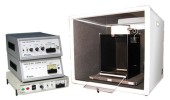Authors
Duclot F, Perez-Taboada I, Wright KN, Kabbaj M
Lab
Department of Biomedical Sciences, Florida State University, Tallahassee, FL 32306, United States; Program in Neuroscience, Florida State University, Tallahassee, FL 32306, United States.
Journal
Neuropharmacology.
Abstract
Only a portion of the population exposed to trauma will develop persistent emotional alterations characteristic of posttraumatic stress disorder (PTSD), which illustrates the necessity for identifying vulnerability factors and novel pharmacotherapeutic alternatives. Interestingly, clinical evidence suggests that novelty seeking is a good predictor for vulnerability to the development of excessive and persistent fear. Here, we first tested this hypothesis by analyzing contextual and cued fear responses of rats selected for their high (high responders, HR) or low (low responders, LR) exploration of a novel environment, indicator of novelty seeking. While HR and LR rats exhibited similar sensitivity to the shock and cued fear memory retention, fewer extinction sessions were required in HR than LR animals to reach extinction, indicating faster contextual and cued memory extinction. In a second part, we found an effective disruption of contextual fear reconsolidation by the N-methyl-d-aspartate receptor antagonist ketamine, associated with a down-regulation of early growth response 1 (Egr1) in the hippocampal CA1 area, and up-regulation of brain-derived neurotrophic factor (Bdnf) mRNA levels in the prelimbic and infralimbic cortices. Altogether, these data demonstrate a link between novelty seeking and conditioned fear extinction, and highlight a promising novel role of ketamine in affecting established fear memory.
BIOSEB Instruments Used:
Startle and Fear System (BX-START&FEAR)

 Pain - Thermal Allodynia / Hyperalgesia
Pain - Thermal Allodynia / Hyperalgesia Pain - Spontaneous Pain - Postural Deficit
Pain - Spontaneous Pain - Postural Deficit Pain - Mechanical Allodynia / Hyperalgesia
Pain - Mechanical Allodynia / Hyperalgesia Learning/Memory - Attention - Addiction
Learning/Memory - Attention - Addiction Physiology & Respiratory Research
Physiology & Respiratory Research
 Pain
Pain Metabolism
Metabolism Motor control
Motor control Neurodegeneration
Neurodegeneration Cross-disciplinary subjects
Cross-disciplinary subjects Muscular system
Muscular system General activity
General activity Mood Disorders
Mood Disorders Other disorders
Other disorders Joints
Joints Central Nervous System (CNS)
Central Nervous System (CNS) Sensory system
Sensory system
